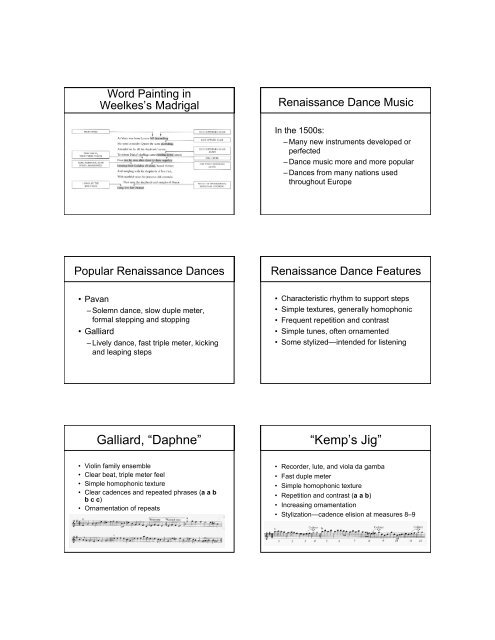Chapter 7 Renaissance Timeline The Renaissance ... - John Chittum
Chapter 7 Renaissance Timeline The Renaissance ... - John Chittum
Chapter 7 Renaissance Timeline The Renaissance ... - John Chittum
Create successful ePaper yourself
Turn your PDF publications into a flip-book with our unique Google optimized e-Paper software.
Word Painting in<br />
Weelkes’s Madrigal<br />
Popular <strong>Renaissance</strong> Dances<br />
• Pavan<br />
– Solemn dance, slow duple meter,<br />
formal stepping and stopping<br />
• Galliard<br />
– Lively dance, fast triple meter, kicking<br />
and leaping steps<br />
Galliard, “Daphne”<br />
• Violin family ensemble<br />
• Clear beat, triple meter feel<br />
• Simple homophonic texture<br />
• Clear cadences and repeated phrases (a a b<br />
b c c)<br />
• Ornamentation of repeats<br />
<strong>Renaissance</strong> Dance Music<br />
In the 1500s:<br />
– Many new instruments developed or<br />
perfected<br />
– Dance music more and more popular<br />
– Dances from many nations used<br />
throughout Europe<br />
<strong>Renaissance</strong> Dance Features<br />
• Characteristic rhythm to support steps<br />
• Simple textures, generally homophonic<br />
• Frequent repetition and contrast<br />
• Simple tunes, often ornamented<br />
• Some stylized—intended for listening<br />
“Kemp’s Jig”<br />
• Recorder, lute, and viola da gamba<br />
• Fast duple meter<br />
• Simple homophonic texture<br />
• Repetition and contrast (a a b)<br />
• Increasing ornamentation<br />
• Stylization—cadence elision at measures 8–9


